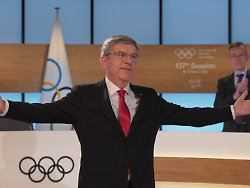Friday, July 16, 2021
Controversial visit before the Olympics
IOC boss causes displeasure in Hiroshima
The Olympic Games start in just over a week, but the hot phase around the world’s largest sports festival has long been underway. The games will take place despite widespread opposition, but the discussions are far from over. An appointment with the IOC boss also causes trouble.
The President of the International Olympic Committee, Thomas Bach, paid a controversial visit to the city of Hiroshima ahead of the Olympic Games. On the first day of the Olympic Peace on Friday, Bach laid a wreath at the memorial in the Peace Park and observed a minute’s silence. Hiroshima was destroyed by an American atom bomb at the end of the Second World War in 1945. The Tokyo Summer Olympics will open on July 23.
Many Japanese are frustrated with how the IOC is pulling through the games despite the corona pandemic and widespread popular disapproval. A citizen group had accused Bach of abusing Hiroshima’s role as ambassador for world peace and called on the government to cancel the visit. An online petition against Bach’s visit was signed by more than 70,000 people by Friday. The fact that the games would be held despite the pandemic is a “disregard for the health and life of people and shows that the games are not a” festival of peace “,” it says.
Bach had defended his controversial visit to Hiroshima against it. “We have nothing to do with politics, we will not politicize this visit,” assured the 67-year-old German. With his visit he wanted to pay tribute to the first day of the Olympic Peace and tie in with a 3000 year old tradition, said Bach. In the Peace Park, a visit to the museum that documents the effects of the use of nuclear weapons was also on the program. The IOC chief was accompanied by Japan’s head of organization Seiko Hashimoto. At the same time, the head of the coordinating commission of the IOC, John Coates, wanted to travel to Nagasaki in southern Japan and visit the atomic bomb museum there and the peace memorial hall.
Of the 350,000 residents of Hiroshima at the time, it is estimated that more than 70,000 were killed in one fell swoop when the American atomic bomb was dropped on August 6, 1945; by the end of December 1945 the number was already 140,000. Three days after Hiroshima, the US detonated a second atomic bomb on Nagasaki in the south. By December 1945 another 70,000 people died there. Shortly thereafter, the Japanese Empire surrendered. Today Hiroshima is a big city and a worldwide symbol for war – and peace.
.
